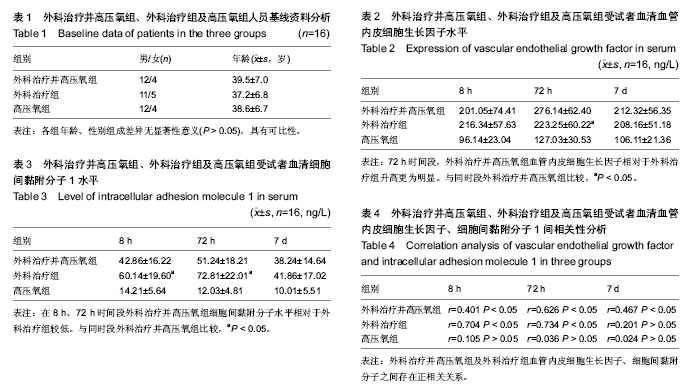| [1] Butler MJ, Chan W, Taylor AJ, et al.Management of the no-reflow phenomenon. Pharmacol Ther. 2011;132(10): 72-85.
[2] Szijártó A, Turóczi Z, Szabó J, Kaliszky P, et al.Rapidly progressing fatal reperfusion syndrome caused by acute critical ischemia of the lower limb. Cardiovasc Pathol. 2013; 22(6):493-500.
[3] Buras JA, Colgan SP, Stahl GL, et al.Hyperbaric oxygen decreases intercellular adhesion molecule-1 mRNA expression in an in vitro model of ischemia/reperfusion. Annals of emergency medicine.2009;34(4):S3.
[4] Baynosa RC, Naig AL, Murphy PS, et al. The effect of hyperbaric oxygen on nitric oxide synthase activity and expression in ischemia-reperfusion injury. J Surg Res. 2013; 183(1):355-361.
[5] Yuan J, Handy RD, Moody AJ, et al. Response of blood vessels in vitro to hyperbaric oxygen (HBO): Modulation of VEGF and NOx release by external lactate or arginine. Biochim Biophys Acta. 2009;1787(7):828-834.
[6] 徐江,黄晓琳.高压氧对脑缺血再灌注大鼠核因子-kB及细胞间黏附分子-1表达的影响,中华物理医学与康复杂志[J],2005,27(5): 259-262.
[7] Fok TC, Jan A, Peel SA, et al. Hyperbaric oxygen results in increased vascular endothelial growth factor (VEGF) protein expression in rabbit calvarial critical-sized defects. Oral Surg Oral Med Oral Pathol Oral Radiol Endod. 2008;105(4): 417-422.
[8] Carla M, Brian K. Hyperbaric oxygen decreases neutrophil adherence in ischemia reperfusion by a VEGF-dependent mechanism.Journal of the American college of surgeons. 2010;201(3):s57.
[9] Shah J. Hyperbaric oxygen therapy. J Am Col Certif Wound Spec.2010;2(1):9-13.
[10] 冯娟娟,何予工,粱维娣,等.脑缺血后立即高压氧治疗对脑缺血再灌注损伤大鼠脑梗塞体积的影响[J].中华物理医学与康复杂志, 2014,36(2):141-143.
[11] Liu S, Shen GY, Deng SK, et al. Hyperbaric oxygen therapy improves cognitive functioning after brain injury. Neural Regen Res.2013;8(35): 3334-3343.
[12] Feng ZH, Liu J, Rong Ju R. Hyperbaric oxygen treatment promotes neural stem cell proliferation in the subventricular zone of neonatal rats with hypoxic-ischemic brain damage. Neural Regen Res.2013;8(13): 1220-1227.
[13] 张陈陈,施莼,王映红,等.高压氧医学伦理问题的编审防范措施[J]. 中国科技期刊研究,2011,22(6):938-940.
[14] 王海东,潘树义,肖宏,等.高压氧舱质量安全管理体系的建立和运行[J].中国医疗设备,2014,29(1):77-79.
[15] 鲍瑞军,张茜,张佩军,等.重复高压氧预处理对大鼠脊髓缺血再灌注损伤保护中环氧合酶-2表达的影响及机制[J].中国老年学杂志, 2013,33(13):3134-3134.
[16] Stoekenbroek RM, Santema TB, Legemate DA, et al. Hyperbaric oxygen for the treatment of diabetic foot ulcers: a systematic review. Eur J Vasc Endovasc Surg. 2014;47(6): 647-646.
[17] Goldman RJ.Hyperbaric Oxygen Therapy for Wound Healing and Limb Salvage: A Systematic Review. PMR. 2009;1(5): 471-489.
[18] Wang YC, Zhang S, Du TY,et al.Hyperbaric oxygen preconditioning reduces ischemia–reperfusion injury by stimulating autophagy in neurocyte. Brain Res. 2010;1323: 149-151.
[19] 王友彬,戚征,高春锦,等.高压氧预处理对皮瓣组织Cx43和TNF- a表达的影响[J].中华航海医学与高气压医学杂志,2013,20(1): 9-12.
[20] 马永信,张振英,吴学田,等.高压氧对移植皮瓣患者血清血管内盘细胞生长因子和缺氧诱导因子-1含量的影响[J].中华航海医学与高压医学杂志,2012,19(5):307-308.
[21] Liu X, Zhou Y, Wang Z, et al. Effect of VEGF and CX43 on the promotion of neurological recovery by hyperbaric oxygen treatment in spinal cord–injured rats. Spine J. 2014;14(1): 119-127.
[22] 戴铁,高春锦,王国忠.脑缺血及高压氧治疗中血管内皮细胞生长因子mRNA表达的研究[J].北京医学,2008,28(10):602-604.
[23] Oliveira N, Rosa P, Borges L,et al. Treatment of diabetic foot complications with hyperbaric oxygen therapy: a retrospective experience. Foot Ankle Surg. 2014;20(2):140-143.
[24] He X, Xu X, Fan M, et al. Preconditioning with Hyperbaric Oxygen Induces Tolerance Against Renal Ischemia-Reperfusion Injury Via Increased Expression of Heme Oxygenase-1.J Surg Res. 2011;170(2):e271-7e277.
[25] Zhou Y, Liu XH, Qu SD, et al.Hyperbaric oxygen intervention on expression of hypoxia-inducible factor-1α and vascular endothelial growth factor in spinal cord injury models in rats.Chin Med J (Engl). 2013;126(20):3897-3903.
[26] Asano T, Kaneko E, Shinozaki S, et al.Hyperbaric oxygen induces basic fibroblast growth factor and hepatocyte growth factor expression, and enhances blood perfusion and muscle regeneration in mouse ischemic hind limbs.Circ J. 2007;71(3): 405-411.
[27] Teas J, Cunningham JE, Cone L, et al.Can hyperbaric oxygen therapy reduce breast cancer treatment-related lymphedema? A pilot study.J Womens Health (Larchmt). 2004;13(9): 1008-1018.
[28] Salgado CJ, Jamali AA, Ortiz JA, et al.Effects of hyperbaric oxygen on the replanted extremity subjected to prolonged warm ischaemia.J Plast Reconstr Aesthet Surg. 2010;63(3): 532-537.
[29] Kendall AC, Whatmore JL, Harries LW, et al.Different oxygen treatment pressures alter inflammatory gene expression in human endothelial cells.Undersea Hyperb Med. 2013;40(2): 115-123.
[30] Kemper TC, de Jong VM, Anema HA, et al.Frostbite of both first digits of the foot treated with delayed hyperbaric oxygen:a case report and review of literature.Undersea Hyperb Med. 2014;41(1):65-70.
[31] Bozok S, Ilhan G, Yilmaz Y, et al.Protective effects of hyperbaric oxygen and iloprost on ischemia/reperfusion- induced lung injury in a rabbit model.Eur J Med Res. 2012; 17:14. |
